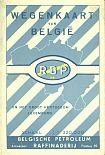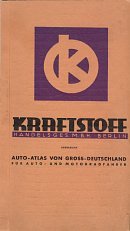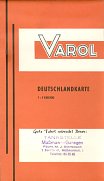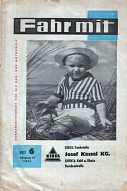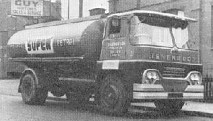OXY
RBP, Kraftstoff, Varol, VIP
Occidental Petroleum was established in Los Angeles in 1920 and stayed a small exploration and production company until 1956 when Dr Armand Hammer made a small investment in one of its oil wells as a tax shelter. He was soon appointed as its President, and over the next decade Occidental rapidly grew to be a major force in the industry. Hammer had a very personal style of management and in the mid-1960s obtained large oil concessions from King Idris of Libya. This left Occidental with a problem: it lacked a secure market for its new African oil, so in February 1968 it acquired the European operations of fellow California company Signal Oil & Gas. Signal owned a refinery in Belgium and a petrol marketing business there and in Britain using the VIP name. This was followed later in the year by purchasing the 136-outlet Varol chain in Germany, as well as other smaller German petrol companies including Kirol and Interpetrol.
Occidental's purchases proved ill-timed, for in September 1969 Colonel Gaddafi overthrew King Idris and threatened to cut off Occidental's oil supplies. Although the company negotiated new agreements with Libya, it lost money through securing ultimately unnecessary alternative supplies for its marketing chains. In 1973, it was forced to sell a 51% controlling interest in its Libyan oilfields to the Government, so decided to withdraw completely from its European refining and marketing, selling its service stations to the French state-controlled company Elf in 1974. |
|
The only known Oxy map was prepared by Falkplan at a scale of 1:300,000 and is dated 08.04.72. The North of Belgium is printed on one side and the South on the reverse. No Oxy outlets are shown but the logo is repeated in the banner above the legend inside the map. The front and back covers differ only in the language used and in the placement and relative colours of België/Belgique. |
The timing of the sale to Elf too may not have been perfect, as before long Occidental found huge new reserves of oil in the North Sea, but it is clear that Dr Hammer was not at heart a marketer of oil; he preferred the excitement of discovering oil (and acquiring other companies!) Oxy itself never had any downstream activities in the USA although it did at one time try to build a refinery in Maine. The company survived Armand Hammer's death in 1990 and continues to this day with interests in oil and gas production and chemicals.
RBP, Raffinerie Belge des Petroles
Brief History
Antwerp's oldest still operational refinery was opened in 1933 by the British Lianosoff White Oil Co. After the war it became RBP (or BPR in Dutch - Belgische Petroleum Raffinaderij), and was sold to Signal Oil & Gas in 1963, and then Occidental Petroleum (OXY) of the USA in 1968, before initially closing around 1977. Subsequently it was acquired by Coastal Corp., then successively Bricout Belgium with Nynäs (from Sweden), Universal Refining (a Korean company), IPG of Kuwait and, since 1999, the Dutch company Petroplus who operated it until their January 2012 bankruptcy. RBP is thought to have mainly supplied independent distributors often operating unbranded service stations (Witte Pomp), but the RBP name was also used on filling stations with candy-striped pumps, as shown below, before switching to the VIP brand after the Signal takeover.
Maps: RBP
|
The left map dates from the mid-1950s & has a similar rear cover, but with French text. It is drawn to a scale of 1:320,000, but no cartographer or printer is credited. The right map (front and rear) dates from 1958 and was by Mantnieks of Brussels. Belgium was covered at 1:500,000 with the whole of Benelux on the reverse at 1,000,000.
|
|
|
Kraftstoff (Varol/Varin)
|
|
Kraftstoff Handelsges.m.b.H. was based in Berlin and used the trade name Varin for its main motor fuel and Varol on its benzole-petrol blend. |
|
By the mid-1960s Varol had become the primary brand name, although the legal company name was unchanged from before the war. Varol now maintained additional offices in Frankfurt/Main and Braunschweig, as well as operating the Mineralölraffinerie Essen-Stadthaven. As noted above, in 1968 its 136 stations were sold to OXY and the Varol name soon disappeared. |
|
Kirol
|
|
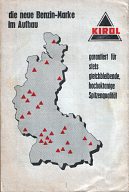 |
Kirol is not known to have issued any road maps. However in 1963 it was the cover sponsor for a Fahr mit ("travel with...") booklet published Dr Holm & Co, Köln. This 16 page booklet on cheap paper was free to motorists and carried articles of general motoring interest, with a few cartoons and small adverts. The front cover is overprinted for Josef Kessel KG, who operated the Kirol filling station in Kork bei Kehl am Rhein, one of cluster of 7 sites. At the time Kirol only supplied 28 locations, as a rudimentary location map on the rear cover showed. |
VIP
|
|
Isherwoods Petroleum was founded in 1934 and owned and operated a small chain of petrol stations in the Manchester area as well as supplying some third parties. This latter activity was scaled back during the 1950s after the introduction of solus sites, until 1960 when the VIP brand was created although this 1966 photo of an Isherwoods road tanker suggests they may have also used a simple "SUPER" identity. |
In late 1963 Isherwoods acquired two smaller wholesalers, Octane (operating in Greater London) and Orbit (in Yorkshire) whose brands were sold at lower prices than any of the leading companies. As a result retail petrol sales rose 10-fold between 1958 and 1964, at the end of which year it supplied 371 stations mainly under the VIP name but still including some selling Octane fuels. VIP initially obtained its supplied domestically, in 1961 around half came from Petrofina or Total, with the balance imported, but by 1964 it had switched entirely to imported supplies (probably from Antwerp) with Signal as its chief supplier. In October 1964 Signal Oil & Gas purchased a substantial interest in the company. Isherwoods' petrol was sold at prices generally similar to Jet petrol yet due to discounts for volume gave retailers a slightly higher margin.
|
After VIP's nearly 800 outlets were sold to Occidental in 1968, the VIP name was retained in the UK, unlike Belgium, but the OXY logo was introduced alongside it on pump decals. The VIP brand was eventually replaced by Elf in 1975. |
|
No VIP branded road maps are known from either Britain or Belgium, but if you have one, then please let me know! I have spoken to a former British VIP dealer who told me that as far as he can recall none were issued during his period with the company. I would also like to know more about Oxy's small Dutch operation.
Thanks to Michel Breugelmans for his help with the Belgian maps on this page.
Text and layout © Ian Byrne, 2005-16
All original copyrights in logos and map extracts and images are acknowledged and images are included on this site for identification purposes only.


